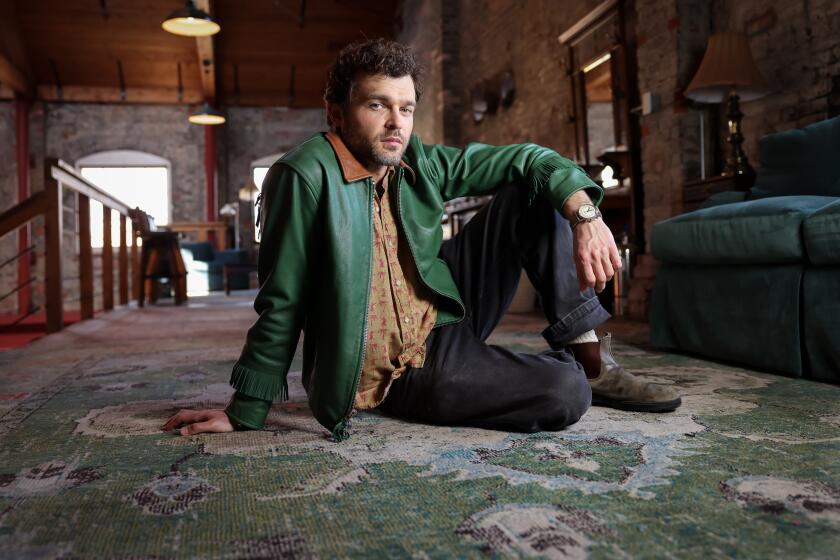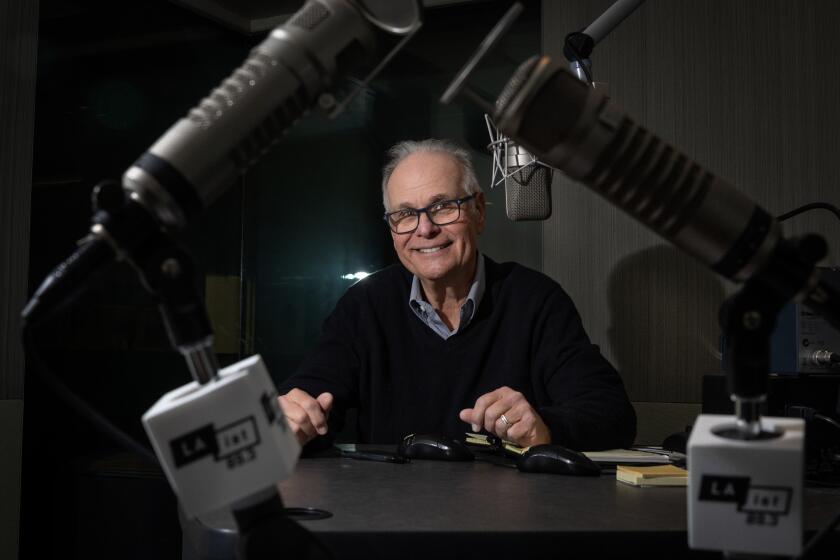From Minneapolis to Inglewood, the shifting politics of NFL stadium design
- Share via
The architectural nostalgia that poured into nearly every corner of Major League Baseball a generation ago, uncorked by the opening in 1992 of Baltimore’s willfully eccentric and doggedly old-fashioned Camden Yards, did very little to change the look of football stadiums. When Super Bowl LII kicks off Sunday inside 2-year-old U.S. Bank Stadium in Minneapolis, home of the National Football League’s Vikings, we’ll get an up-close look at how loyal football has remained to a self-consciously futuristic, if often sleekly anodyne, approach to design.
Much like Atlanta’s new Mercedes-Benz Stadium, AT&T Stadium in Dallas (2009) and the University of Phoenix Stadium in Arizona (2006), the Minnesota stadium is a monument to the idea that football, in great contrast to baseball, must always be moving forward. Designed by HKS Architects and built at a cost of $1.1 billion, among its most dramatic design elements — just to drive the the point home — is a sharply angled exterior wall that the architects call “the prow.”
Sometimes this forward motion can feel like a forced march to the tune of a corporate drummer from the NFL’s home office in New York. It’s surely a sign of pro football’s impatience with middle-aged buildings that the HKS stadium replaced another design for the Vikings that in its own day was meant to look cutting-edge: the Hubert H. Humphrey Metrodome by Skidmore, Owings & Merrill. That building, an underrated design in a genial version of High Tech, was demolished in 2014, the year it turned 32.
Yet from a number of points of view the relationship between football and the future is looking shaky these days — raising the question of how long architects and cities will continue to buy into the idea that the sport’s popularity is destined to rise eternally. Or, for that matter, into the idea that it makes sense, in the middle of a crushing housing crisis in Los Angeles, for a city to roll out the red carpet for NFL owners who want to use a major piece of land for a new stadium, as Inglewood has done for the $2.6-billion future home of the Rams and Chargers.
When pro-wrestling tycoon Vince McMahon announced last month that he hopes to revive the XFL, the alternative football league that never made it past its debut season in 2001, he described the reboot as a throwback to a time when athletes respected the flag and the law. No kneeling during the national anthem will be allowed.
“People don’t want social and political issues coming into play when they are trying to be entertained,” he told ESPN. “We want someone who wants to take a knee to do [that] on their personal time.”
It was enough to make you wonder if the stadiums where the new XFL teams play would be similarly old-fashioned, with architecture to match McMahon’s make-football-great-again rhetoric.
Growing concerns about head trauma and the brain disease known as CTE, meanwhile, have begun to thin the ranks of youth football leagues and cast doubt on the long-term viability of the NFL, or at least its crushing dominance over the national TV ratings. If we haven’t yet reached Peak Football, we likely soon will.
What all of that means for the relationship between football and architecture — or more to the point, between football and the politics of land use and urban planning — was a question very much on my mind as I joined a group of journalists last month on a hard-hat tour of the massive NFL stadium under construction in Inglewood.
Known for now as the Los Angeles Stadium at Hollywood Park — likely a placeholder until a corporate sponsor ponies up for naming rights the way United Airlines just did at the Coliseum — it’s being built just south of the Forum. The site lies so directly under the path for flights descending into LAX that the playing field had to be sunk 100 feet below street level to avoid running afoul of FAA regulations.
More than two years ahead of its planned opening in fall 2020, the stadium, designed like the Minneapolis stadium by HKS and to be shared by the Rams and Chargers, is already a success in terms of the pecking order of major sporting-event venues. It will play host to the Super Bowl in 2022 and the following year to the college football title game. In 2028, when the Summer Olympics return to Los Angeles for the first time in more than 40 years, the stadium will play a major role (along with the Coliseum) in the opening and closing ceremonies. As an architectural symbol of Los Angeles — given all of those opportunities for blimp shots — it may be rivaled among 21st-century landmarks only by Walt Disney Concert Hall and the Broad museum.
Nonetheless, as I spent a morning hearing about the amenities it will offer, I kept coming back to a couple of basic questions. Is this a stadium that greater Los Angeles, in any rational sense, actually needs, especially given that the Coliseum is undergoing a major upgrade of its own, with a budget of nearly $300 million? A better question might be this: In choosing to build the Inglewood stadium, what are we choosing not to build?
It took us at least five minutes to ride from the trailer on one edge of the Hollywood Park site where we began the press tour to the pit from which the stadium itself is beginning to rise. That should give you a sense of the vast scale of the property as a whole, which covers 298 acres; the stadium, big enough to hold 70,000 fans for regular-season football and 80,000 for the Super Bowl and other special events, is but one element of its redevelopment plan. In later phases, according to developer Wilson Meany, the site will hold a residential neighborhood with 3,000 new units along with a 300-room hotel and extensive retail space. Those non-football plans, in fact, predate the stadium project.
Because the stadium will be largely paid for outright by Rams owner Stan Kroenke (with the Chargers chipping $200 million borrowed from the NFL), it has escaped some of the scrutiny and skepticism aimed at projects that rely on public funding. (U.S. Bank Stadium’s financing included roughly $500 million in city and state money.) And because the site is eventually meant to include some housing, it stands apart from the stadium designs that proliferated in the 1960s and 1970s, concrete donuts rising in the middle of vast parking lots.
Yet to defend the use of the Hollywood Park for a football stadium because some fraction of the site will hold new townhouses and apartments is to overlook one key fact about development in Los Angeles and the roots of the housing crisis, namely that land use here has become a zero-sum game. Big, open parcels like Hollywood Park are a vanishing breed; the region is essentially built out. The question now is how we redevelop large sites not from scratch but for the second or third time around, as growth, instead of spreading outward toward the edges of greater Los Angeles, folds back toward the middle.
When earlier stadiums were built in Southern California — the Rose Bowl, the Coliseum, Dodger Stadium and Angel Stadium, to name four of the most prominent — the region had enough open land to accommodate a number of competing civic visions, some dense and vertical, others low-rise and suburban, still others Arcadian or nearly rural. Even if the site where Dodger Stadium wound up had been contested for years, for much of the last century it was possible in Los Angeles to build the housing we needed and the cultural and athletic facilities we wanted and still have space left over.
That is no longer the case. When the NFL was considering a site downtown for a new stadium, the design, wedged into a relative sliver of land between the convention center and L.A. Live, reflected at least to a degree these new realities. When Inglewood Mayor James T. Butts Jr. moved aggressively to fast-track the new stadium once it moved outside the L.A. city limits, on the other hand, even helping the project earn an exemption from California Environmental Quality Act rules, he doubled down on a vision as outdated in planning terms as Vince McMahon’s is in cultural ones.
In choosing to build the Inglewood stadium, what are we choosing not to build?
Any large-scale project we choose to build now in the urban core of L.A. County should be analyzed, even simply as a thought experiment, in terms of what else its site might contain, using a version of the “highest and best use” test that keeps our housing supply squarely in mind. Imagine — as I found myself doing repeatedly during the hard-hat tour of the stadium site — those 298 acres dedicated almost entirely to a mixture of affordable and market-rate housing.
In general a good rule of thumb for building a humanely scaled urban neighborhood is to aim for the density of brownstone Brooklyn or central Paris, which is to say the density created by four- and five-story residential buildings, with taller buildings and retail spaces both threaded through it and strung along its edges. Anyone who has spent substantial time in either place knows those neighborhoods are a far cry from the tower-filled nightmare districts opponents of new housing often raise as the inevitable product of denser land use. In reality they tend to be tree-lined and walkable: low-rise enough to feel convivial, but with population density high enough to support local shops and public transit.
Brownstone Brooklyn has up to 50 residential units per acre. That means the Inglewood site, using some admittedly back-of-the-envelope math, is big enough to hold 15,000 new apartments without feeling overstuffed or overburdened.
Fifteen-thousand! In one fell swoop!
It’s a myth that we don’t have enough land in Los Angeles to solve the housing crisis, or that solving it will require turning ourselves into some over-packed version of Hong Kong or Manhattan. We’re suffering through that crisis for a number of reasons, but chief among them is our tendency to behave, when it comes to major land-use decisions, as if it’s still 1960, as if we can find acreage to build new housing and at the same time please the billionaire owners of sports franchises with regulatory and other concessions.
Replace a racetrack and its parking lot with a professional football stadium (and its parking lot), with plans to sprinkle in some housing in a separate phase? That swap should sound logical to you only if you believe the housing and homelessness crises are no big deal. And I haven’t talked to anybody in Los Angeles lately who believes that.
christopher.hawthorne@latimes.com
Twitter: @HawthorneLAT
More to Read
The biggest entertainment stories
Get our big stories about Hollywood, film, television, music, arts, culture and more right in your inbox as soon as they publish.
You may occasionally receive promotional content from the Los Angeles Times.











